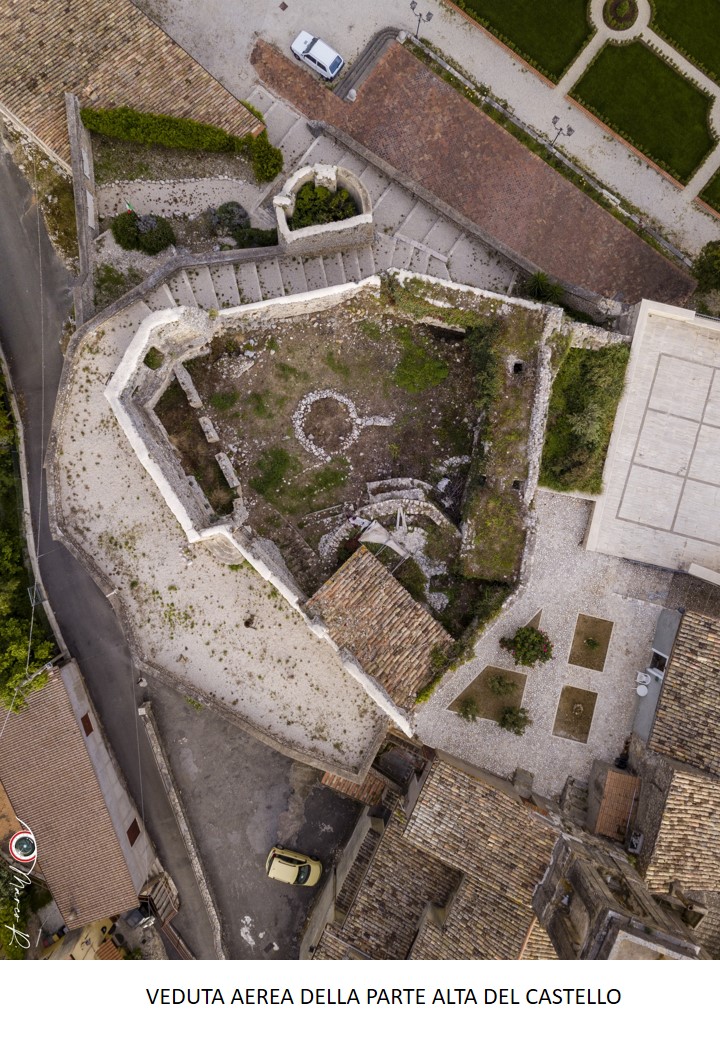The alleged “crime scene” that is to say the place where the skeleton would have been found, is located inside the castle of Poggio Catino and more precisely in the highest part of the fortress. It therefore appeared to us to preliminarily carry out an accurate study of the castle of Poggio Catino, its origins and its architectural development. Podium de Catini (Poggio Catino) According to different historical sources, he was born following an operation for the fitting of a scattered settlement located near the “Castrum of Catino” wanted by the abbey of Farfa to make its defensive system more efficient and to accommodate a more substantial population, not having a basin of a basis of an urban expansion given the difficult orography of its positioning (dynamic on which, as afraid in a previous chapter, the authors of this essay do not fully agree). Historical news about his birth are reported in the Farfense Regesto (IV – Doc. 809– AN. 1047 – 1089, p. 211) and in the Chronicon Farfense (II – Page 122) of Gregorio da Catino. Among the assets that the abbey acquires there is also the “‘podium” and on this Colle Bernardo I built the new castle probably in the decade 1070 – 1080.
In the book by G. Morocco, Monuments of the Papal States and topographical relationshippublished in Rome, in 1833 (I volume the, ad vocem Poggio Catino, pp. 19-20) we find the following description (reported in full with those that could seem now about spelling errors but which are linked to ancient writing):
«…This place gives the title of Marquisate to the illustrious Olgiate family, title established by Clemente Vili on 13 August 1596 in favor of the lords of it Castello with absolute authority and domain ” The archpriest and parish church dedicated to San Nicola di Bari is “On one side of the Olgiate Baronal Palace, quite vast, since there are four apartments from each other neatly divided, which is contiguous a vague garden. The internal roads are a little steep, but the short stretch of that of the sunny village is flat, and very decent. The union of the Fabricate of the whole Castle forms its circumference wall, and bears in its total the figure of a hobby, however having four towers around, as behind the parish church observed the vestiges of an “ancient fort”…».
In practice, the whole town of the historic center of Poggio Catino would have constituted “the castle” in the past. From this summary description, dating back to the first half of the nineteenth century, it is understood that the inhabited area is delimited by a wall in some sections also made up of the walls of the houses, which recalls the shape of a cembalo, a musical instrument near the shape and mechanics on the piano.
The perimeter of this belt is marked by four towers although the investigations carried out allow the identification of five towers (circular section) and salient structures, also for access, according to broken and advanced. It should be noted that the oldest fortress, placed on the top of the relief, lapped and connected to the walls, later, is interpreted by Morocco as “ancient fort”, with an expression of seven -eighty -five. On the text V. Stazi Fabrizi, A thousand years of history of Catino and Poggio Catinoprinted in 2002, and published by the Cultural Association “Beyond the bridge“Together with the Pro Loco of Poggio Catino, he concerned, writes Raffele Ricci, the transcription of the work of V. Stazi Fabrizi (Catino 1864 – Poggio Mirteto 1935); Silvano Soavi, moreover, “He edited the cleaning of the tables and restored color to the coats of arms, as he remembers having seen them in the original of the work never done».
And in fact, for the purposes of the investigation, the most important contribution of this press is precisely the table that proposes a naive view of Poggio Catino taken from the west as well as a plan of the town both accompanied by captions as well as by the diction “Poggio Catino, prospectus and plant towards the year 1500”.
Moreover, it is not indicated by which documentation V. Stazi Fabrizi draws these elements that, moreover, appear quite likely and largely confirmed by the material traces existing today and verified by means of inspection on site. This contribution is revealed important for the identification of the route of the walls and the “fortress”, albeit renovated, evidently preceding the walls themselves.
Interestingly, note the autonomy of the “fortress” building compared to the “castle” entity: with the latter term, in fact, with a later terminology than the fully medieval one, the whole fortified village and the table is clearly indicated, in letter H, identifies the “perhaps double walls gave the shoe surrounding the whole castle“. The word” castle “can refer to a wide variety of structures, from antiquity to the seventeenth century; it assumes meanings that vary both in relation to the geographical context and in relation to the chronological documentary context in which the same is used, and in relation to the permanence or linguistic transformation in a given cultural team. Just before the modern architectural evolution,” Castle “therefore becomes and above all if surrounded by walls, Its complex to which it persists, evolved in the forms or abandoned, the primitive defensive fortification, fully medieval.
Frequently in the late Middle Ages, persisting in the following centuries, “Castello” is a group of buildings closely connected to the pre -existing fortification, a group of houses perched on a rocky spur whose external walls act as a fortified belt. The ancient fortification in which feudal powers could be exercised is distinguished from the later fortified inhabited inhabitant – generally non -urban – in which palatial buildings can be found; It is often called “Rocca” (or also “cassetting” in Tuscany) and has recently acts as a military receipt or residence if the characters have been changed. From the “fortress”, if not directly from the oldest fortification, in many geographical areas you reach fortified structures and to the Fortress to the modern, technically and balistically much more evolved as well as in the race with the evolution of oxidinal techniques.
On the basis of what is analyzed, as in other realities, in Poggio Catino some poles of interest can be distinguished: at least from the mid -sixteenth century the forty Rocca, the large baronial palace, the adjoining garden to the Italian, the walls consisting of the same homes that follow the differences in height and natural terraces, some towers and certainly salient or turritis, are distinguished.
The castle of Poggio Catino is however a fairly complex structure that has undergone numerous changes and extensions over the centuries. The highest part, completely discovered (called “La Rocca”), would be the place of discovery of the skeleton.
In particular, the discovery point of the lady skeleton would have been close to one of the walls. The castle currently pours into shameful conditions and unfortunately not dissimilar by many other fortifications, not only ruins, of which the beautiful country has sprinkled. With atmospheric agents and with the simple passage of time the walls and other internal structures are crumbling. About fifteen years ago a thin layer of concrete was pityfully deposited on the upper part of the walls to try to reduce the inexorable fall of the stones and the flaking of the walls. But for the rest this wonderful fortification has been left to its destiny for years. A few tens of thousands of euros would be enough to make it safe and to effectively fight the destructive work of the time but this important need for the protection of our historical roots is obviously not understood or considered necessary by the institutions.
In some European places, such as in Germany France or England, some ruins much less flashy and prestigious of the Castle of Poggio Catino are held with religious care and are visited by thousands of people every year who, among other things, bring relevant economic revenues to the countries that host them. And this is common experience. By way of example, the castle of Tintagel in Great Britain, which legend places as the famous “Camelot“Of the saga of King Arthur and the knights of the round table, it is actually made up of a few ruins and some stone walls. The castle of Tintagel He was visited years ago by the authors of this essay with a consequent strong disappointment. Nothing to do with the castle of Poggio Catino which has more impressive structures and that has much more charm. Why then slowly let such a fascinating historical testimony die that it could bring luster and economic induced (tourist)? Because every year the castle of Tintagel Is it visited by thousands of passionate tourists who spend their money in the dozens of souvenirs shops, who eat and drink in the many rooms inspired by the knights of King Arthur and therefore “keep” almost the entire population of the town, while the castle of Poggio Catino is known practically only by the inhabitants of the country and by a narrow circle of medieval history scholars? But let’s go back to the castle of Poggio Catino.
Some crimes, perhaps, may have occurred, evidently and perhaps serious compared to the killing of a woman but not for this reason not able to cause disdain in men of good will. Around the seventies of the twentieth century, for example, the ownership of the castle and the annexed noble palace had been acquired by a rich French actress, such Yvonne Fourneaux Which made several renovations carried out and later the ownership of the castle passed to an American rich man, who inside the central bastion made a horrible abusive construction in tuff, leaning and cemented on the medieval wall and which contains cassones for water in eternity (currently in disuse) built.
Later, around the eighties, one of the former mayors of the country, Emeraldo De Feliceto create public housing with reinforced concrete structure to be presumably granted to some local families, he made a part annexed to the medieval era castle that contained ancient premises destined perhaps to prison and other services of the time knocked down. The elderly of the country tell that in these demolished premises there were even inscriptions and graffiti of medieval times. The project to create public housing was later blocked and the modern construction (leaning against the south of the castle) now houses the Congress Center “Ladies Bianca”, A modern local strident poorly used intended for meetings and conferences.
We hope that the next generations of public administrators can try to save and enhance what will remain of the unseemable heritage that Italian history has left us and that is often left to deteriorate.






News
Berita
News Flash
Blog
Technology
Sports
Sport
Football
Tips
Finance
Berita Terkini
Berita Terbaru
Berita Kekinian
News
Berita Terkini
Olahraga
Pasang Internet Myrepublic
Jasa Import China
Jasa Import Door to Door



